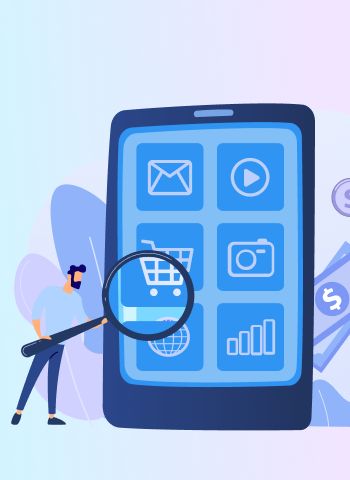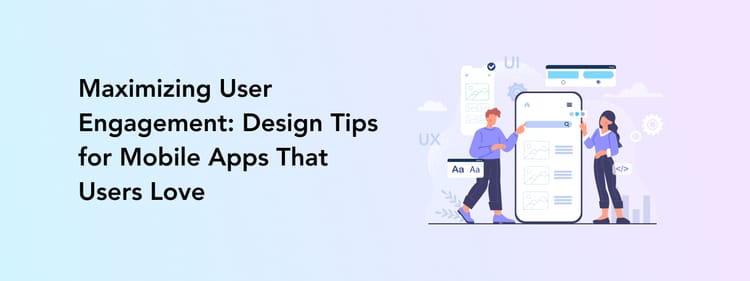Banking apps are boring — that’s just how they are, and it is how they should be. Is it what you believe too? Let’s be honest, what do we usually expect from a fintech app? Plain financial terms, a list of statements, maybe a simple graph to sum up your monthly expenses.
But it doesn’t have to be like that. Fintech apps can be simple, likable, and even fun. Let’s explore how to create a UI/UX design for a fintech application that rocks.
The main types of fintech apps
Most of us use fintech apps daily or a least several times a month: to send or receive money, check statements, calculate mortgages, or simply keep track of one’s budget. Fintech applications include:
- Banking apps (created for a particular bank, like the Bank of America Mobile Banking app)
- Neobanks (banks that exist only virtually and don’t have offline branches, like Chime or Estonian Wise app)
- Payment systems for sending and receiving money (for example, PayPal or Payoneer)
- Loan apps (e.g., Empower or Money View)
- Personal finance apps for managing one’s budget (like Mint or Goodbudget)
- Trading and cryptocurrency apps (for example, Coinbase or Bitstamp)
- Mortgage and insurance calculator apps (e.g., Mortgage by Zillow or GEICO)
Of course, there are also lots of apps that fall in between these categories. Often enough, users can check their balances, make transactions, and analyze their budgets in one application. So what are the must-have features of such a hybrid app, and which functionality can take it a step forward? Let’s explore.
Must-have and advanced features for a superb fintech app
There is a set of features any good fintech application can’t go without. These include:
- Login and registration
- Personal account
- Transaction history and statements
- Tools for sending money
- Finance reports and statistics
- Finance management, like setting spending limits
- Security measures, like changing passcodes, freezing the card, and setting up notifications
It is the minimum set you need to provide your users with. When it comes to making an application that gives users more control over their finances virtually, consider adding these features:
- Onboarding for introducing the user to the app’s functionality
- Chatbots for immediate assistance or redirecting the user to a service specialist
- Transaction templates. For example, users can set up monthly payments for utilities
- More advanced security, like biometric login and action confirmation, two-step verification, and KYC (Know Your Customer) identification system
- Cashback or gamified reward system
- Deposit system
- QR code scanner
With this extra functionality, your app design won’t be just practical but safe, highly customizable, and fun. Remember that while focusing on creating an app that is not boring and gives users some extra features like gamification or convenient finance analytics, you need to fulfill the basic security requirements too.
Top challenges in the fintech app UI/UX design and best practices to solve them
Okay, now we know all the features our future fintech app needs to have. Suppose we have created a user persona, figured out their pains, came up with the features, and drafted wireframes. The biggest challenge is already behind us, right?
Well, not quite. As you might already know, fintech solutions are not that simple. They have to combine user convenience, a high level of security, and some complex financial transactions. It might not be so easy to achieve. But no worries, there is nothing impossible. At Perpetio, we had a chance to design several fintech apps, and let us tell you that with careful research and determining functionality prioritizing, a close-to-perfection fintech solution is more than doable.
Let’s take a look at four challenges a designer should keep in mind when working on a fintech app and how to overcome them using best practices.
Ensuring the security
We said it once, and we will repeat it again — security is a top priority for any fintech app out there. No one wants to lose money because the app didn’t protect their finances from scammers. Unfortunately, people have always wanted to take advantage of others, so a reliable security system is a must.
First of all, it’s best if your app features some advanced security elements, like two-step verification, biometric login, and transaction confirmation along with Know Your Customer identity verification system.
Your task as a designer is to make sure that your users feel safe and understand why the app asks for certain information. It’s best if, while asking for any kind of data, you shortly explain how it will be used. Let’s be honest — no one likes exposing their financial details online. That’s why your users need to be sure that their information won’t be shared with third parties. During onboarding, you might explain the app’s policies and list the type of information you will be collecting later on.
While, in general, we expect any UI/UX design to be frictionless and effortless, sometimes friction is exactly what your users need to feel safe. When it comes to financial transactions, it’s best to make your users think twice — the operation should not be easily confirmed just with one tap. Add a pop-up window asking if the transaction should happen with the option to cancel it. After all, sometimes we all press on something by accident, so it’s essential to ask users to confirm any financial transaction.
Managing the data
Any fintech app revolves around complex financial information. It is something given. At the same time, it is up to the designer if users have to face these complexities directly. Instead of reading complicated messages full of specialized terms, offer your users simple and actionable ones.
UI copy is critical in the case of fintech apps — with too many unknown terms and complex formulations, not only your users might miss a point of the message and feel lost, but the application can get an unfriendly touch to it. Speak to your users in their language — most likely not many of them are finance experts. Your app should be understandable no matter your education or financial background.
At the same time, in some cases, financial terms cannot be avoided, and you just have to use them. Otherwise, you might be creating misinformation and confusing your users with synonyms. If you understand that a particular buzzword has to stay there, don’t hesitate to explain it. For example, you can create a little glossary page or pop-up when a user opens a particular page for the first time.
The next point of data management in a financial app is visualization. Yes, we are talking about graphs. For example, when it comes to users’ monthly spending, you can simply list each category in a text, but why would you do it? Providing a nicely designed chart with clear color indications is what your users will thank you for. Data in fintech apps shouldn’t be something too tedious or complicated. After all, you are adding this information not just for its sake but for users to interpret and utilize it for better financial management.
That’s all about UX. When it comes to fintech’s app UI, fonts are what you should be looking out for. Usually, such solutions include lots of symbols, like $ or €, as well as decimals. Be careful about your fonts and make sure these symbols look good in the UI.
Improving overall user experience
Okay, now we know how to overcome the challenges of providing a high level of security and managing data effectively in your app. Following these tips, you can create a UI/UX design that is well-organized, clean, and easy to manage for the users. But how to make it not boring? How to create not just an app that one has to use out of necessity but wants to use? Let’s discuss.
There are several ways to make a fintech app that gives its users something more:
- Gamification is a technique of adding game mechanics into a non-game environment. For example, our favorite reward systems are nothing else than gamification! Apart from rewards, your fintech app can involve levels and unlocked achievements, set challenges, or even offer users quizzes on financial topics.
- Creative UI design is no less important if you want to make a fintech app that is a bit more than just a set of necessary features. If you are making an investment application, a simplistic UI with a dark theme is exactly what your target audience needs. At the same time, those who are looking for an app to keep track of their day-to-day spending can find such a design too serious and strict. In this case, a set of original illustrations or bright colors in the UI can be very suitable. It is important to remember, though, that any finance-related application should feel secure and reliable, so try not to make a design that can be associated with entertainment. For example, how about some neon in the UI? That’s what we did in one of our recent banking apps.
As a result, your UI/UX design should combine the elements of a trustworthy, serious solution and an educational and even somewhat entertaining app that feels easy to use. Many people dread banking apps for a reason, so a well-designed, modern application can show them that managing finances online is simple and convenient.
Cultivating healthy financial habits
Speaking of education, a fintech app is usually more than just a tool for sending or receiving money. Users tend to look for convenient finance analysis and reporting in the same solution. We have already talked about data management — the reports that users are getting about their spending or savings should be as simple as ABC and clear even with one glance. For example, a color-coded pie chart is probably the most popular yet highly effective way to share financial information.
Such accessibility of information can teach your users to manage their finances more effectively and get more responsibility for their spending. For instance, seeing a percentage of income spent on eating out can give users insight into how they might optimize their finances if necessary.
Take a look at our design of a banking app: there is a report divided into categories for each month or even day. Thus, a user can see if, for example, their cinema budget is a bit over the top.
Additionally, introducing such features as setting limits for spending of certain categories, like online shopping, or basic investment options can help your users with developing financial mindfulness. For example, in one of our banking app designs, users can set a monthly budget for each category and see if they are approaching the limit.
Summing up
Fintech apps are something most people need to use in everyday life. From such simple tasks as sending money or keeping an eye on one’s budget to more complex financial operations like making crypto investments, various mobile applications are there to make finance management simple.
Taking care of one’s money shouldn't be hard or scary — the times of constant visits to the bank are in the past. Still, complicated, unintuitive, and hard-to-navigate apps might be the obstacles that stand in the users' way to healthy financial habits. As a UI/UX designer, your task is to make these solutions as welcoming as possible and demonstrate to your users that taking care of their money is not a headache.
Our design team is excited to work on new projects, fintech included.





